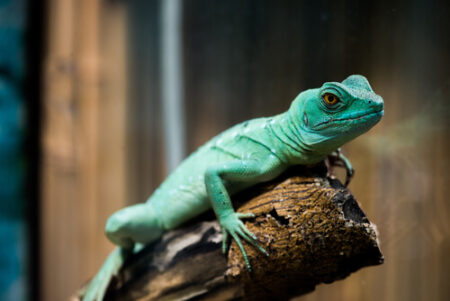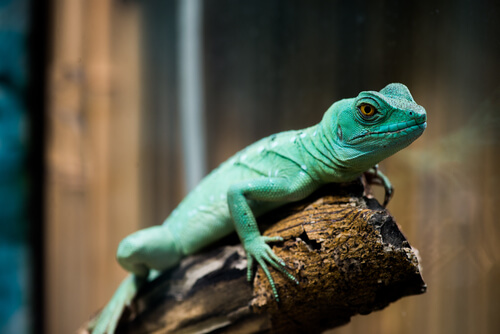 We explain what cold-blooded animals are, their characteristics and various examples. Also, what are warm-blooded animals.
We explain what cold-blooded animals are, their characteristics and various examples. Also, what are warm-blooded animals.
Hear
3 min. Reading
It is common for cold-blooded animals to expose themselves to the sun to warm up.
What are cold-blooded animals?
Cold-blooded animals are those that depend on their environment to regulate their body temperature , and therefore usually have a temperature slightly higher than the environment where they are. In this they differ from warm-blooded animals , capable of regulating their metabolism regardless of where they are.
This difference is known as thermoregulation . Thus, it is common for cold-blooded animals to expose themselves to the sun to warm up, for example, or to cool down by withdrawing into the shade, burying themselves in the ground or submerging to greater depths in the water (since it is usually colder). ). Among these types of animals are reptiles , amphibians , fish and invertebrate animals .
Although in biology the terms “cold blooded” and “warm blooded” were traditionally used to differentiate animals, today they are considered archaic terms. As the dynamics of life are better understood, it has been discovered that reality is more complex and that there are no animals entirely dependent on the environment to regulate their temperature, that is, totally “cold” blooded .
For this reason it is currently preferred to use “cold blooded” and “warm blooded” as the extremes of a spectrum into which animals can be classified. Seen this way, it is possible to distinguish between three types of animals on the “cold” side of the spectrum:
- Ectothermic animals(from the Greek ectos , “outside”, and thermos , “temperature”), which control their body temperature through environmental elements, that is, external elements.
- Poikilothermic animals(from the Greek poikilos , “varied”, and thermos , “temperature”), which tend to equalize their body temperature with that of the environment, so they can present varied temperatures.
- Bradymetabolitermous animals(from the Greek brady , “slow”, metaboli , “to change”, and thermos , “temperature”), which have a low metabolism during rest periods , with low temperature, but which can “turn on” from one moment to the next. another according to your needs.
Most “cold-blooded” animals fall into one or two of these categories, depending on the level of complexity of their internal organs and the type of habitat in which they exist.
See also: Homeostasis
Characteristics of cold-blooded animals
Cold-blooded animals require long periods of rest and torpor.
In general, cold-blooded animals are characterized by:
- They have slow metabolisms, which produce little heat , so they require long periods of rest and torpor.
- They are more dependent on the environment than warm-blooded animals. That is, they are more susceptible to changes in the environment, since their body temperature depends on this.
- They tend to be more simple in the body, since their organs have less energy to consume. For the same reason, they require less food quotas than warm-blooded animals.
- They have a higher amount of enzymesin their body , as they require extra effort to keep their metabolism going. For this, poikilotherms often have larger genomes than warm-blooded animals.
Examples of cold-blooded animals
Grasshoppers need the heat of the sun to be able to jump.
The following are examples of cold-blooded animals:
- The iguanas. These sauropsid reptiles with a scaly body, green or brown, are typical of the tropical regions of Central and South America and the Caribbean. Their lives are spent mostly in trees, since they are excellent climbers, and there, too, they can be exposed to sunlight for long periods of the day, to warm their bodies.
- The grasshoppers. Also called grasshoppers, charates, sanagustines, or locusts, these herbivorous insects are great jumpers and flyers, as long as their bodies are warm enough to activate. At dawn on a cold night, for example, their bodies and joints will be too stiff and cold to fly and jump, so they will have to wait for the sun to warm them up.
- The scorpions. These arachnids are among the world’s largest predators of insects and it is possible to find them in very extreme habitats, such as the desert. In these cases, the scorpion usually adopts nocturnal habits, to escape the burning daytime temperatures and desiccation, although it can withstand very high and very low temperatures thanks to a continuous production of sugars (trehaloses). Faced with cold environments, scorpions enter a hibernation mode in which they reduce their energy consumption as much as possible.
- The crocodiles. These large amphibious reptiles, typical of rivers, lakes and even seas, combine exposure to the sun for long periods of immobility with dips in the water to control their temperature. Even on the African plains of boiling summers, they often roll in the mud to cover themselves with a cloak to block the sun and keep cool.
- The fishes. Most bony fish, that is, those that have an internal skeleton, resort to environmental strategies to warm themselves, since their body temperature is only a few degrees above that of the water . Thus, in warm waters they retain heat, and can descend to the lower layers of the sea, where less sunlight reaches, to cool off with the colder water. While in cold waters, they tend to seek the surface to capture more solar radiation and warm up.
Other examples of cold-blooded animals are:
- Land andsea turtles .
- Cartilaginous fish, such as sharksor rays.
- Large land lizards, such as the Gila monster or the Komodo dragon.
- Vipers and snakes, both terrestrial and aquatic.
- Crustaceans and arachnids in general: spiders , lobsters, crabs ,among others.
- Toads, frogsand salamanders of all kinds.
- Ants, beetles, cockroaches and insects in general.
warm blooded animals
Traditionally, warm-blooded animals are those capable of regulating their internal temperature independently of the environment . This means that they have their own strategies to cool or heat the body, such as sweating, shivering or increasing and decreasing the metabolic rate. Warm-blooded animals are entirely mammals and birds, including humans .
